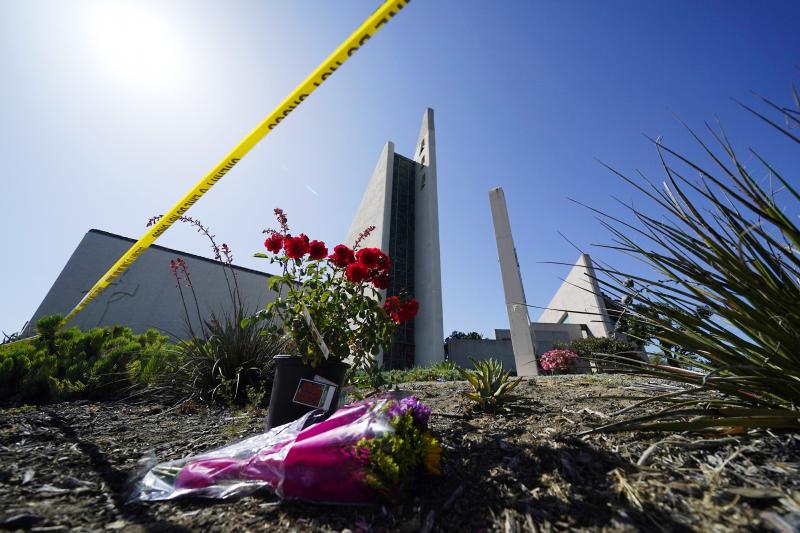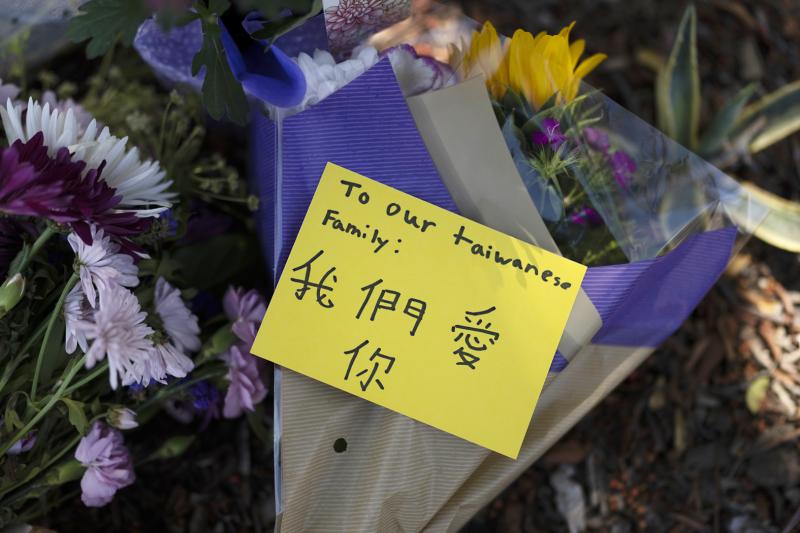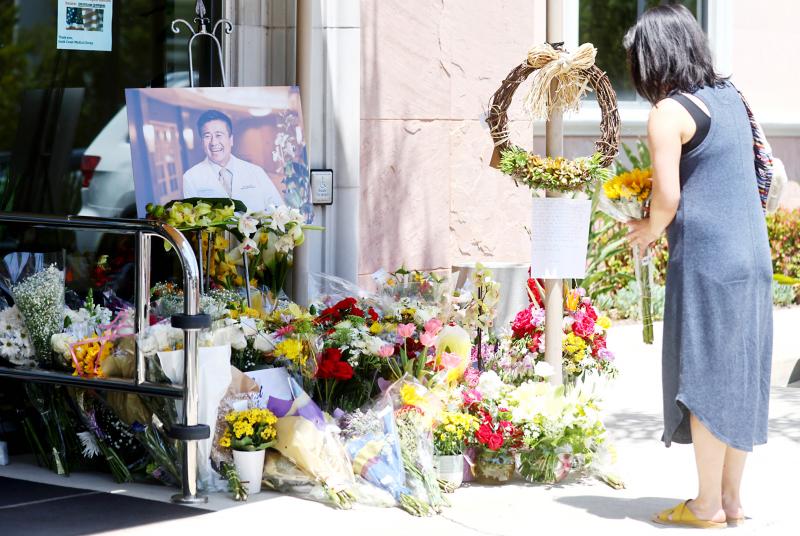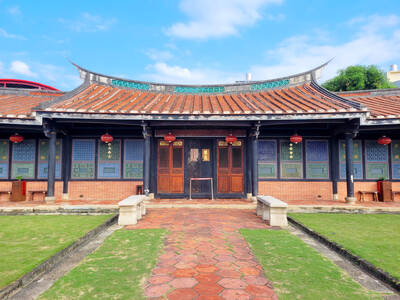The toll rolls on. A gunman walks into a place where humans are peacefully gathering and slaughters them for a militantly-avowed racially-based nationalism, presented in a long manifesto.
We are quickly told that the gunman was mentally ill. Obviously — who but a madman could do such a thing? The newspapers dust off one of their “education of a killer” pieces, change the names and run another 1,200 words useful only to those cultivating such killers.
The latest of these attacks, on Taiwanese churchgoers in Laguna, California, has spurred much discussion of the long record of Chinese Nationalist Party (KMT) violence against Taiwanese. It is indeed related to that, in the same way that the actions of the killer in Buffalo last week are the bastard children of the ideology of white supremacist violence and authoritarian surveillance of the slave-owning South.

Photo: AFP
‘STOCHASTIC TERRORISM’
These killers are engaged in what is known as “stochastic terrorism,” a useful term for killings not intended to accomplish a specific political purpose (the way the murder of Chinese-American journalist Henry Liu (劉宜良) in California in 1984 silenced a dissident voice or the beatings administered to Taiwan independence activists at Little League championships in the 1970s punished them), but to simply spread their ideology of murderous hate. They kill so that others will kill, a steady drip-drip of terrorism.
The manifesto is thus as important to the purpose of the killer as the dead bodies — the dead are glittering trophies, empirical demonstration of the power of the ideology, meant to grab the attention of the media and prospective adherents, enabling the ideology in the manifesto to replicate itself.

Photo: AP
Unlike state-orchestrated violence, stochastic terrorism is ideologically driven and presents itself in the form of an unpredictable “lone wolf” killer. People who forward these terrorist ideologies across the Internet know perfectly well that a given number of individuals will become radicalized and some of these will engage in mass murder.
Thus the term “stochastic,” a reference to the statistical likelihood of someone carrying out a mass killing, given a wide enough dissemination of violent ideas. This distance between the cultivators and their targets enables the directors of this violence to escape any penalty for their actions, and the platforms they use to remain virtually unregulated.
Free speech, you know. We are now confronting an onslaught of it in the Chinese language sphere.

Photo: AFP
SOCIAL MEDIA’S VIOLENT RHETORIC
Kevin Slaten, a researcher of Chinese politics and civil society, sent some numbers around showing how exterminationist rhetoric directed against Taiwanese independence and democracy advocates has been rising rapidly on Twitter. Slaten pointed out that a photo of the Laguna killer has him at a meeting of one of the Chinese United Front anti-democracy and anti-Taiwan hate groups, indicating a banner that proclaims “quickly exterminate independence devils” (迅猛滅獨妖).
Slaten reports of the well-known call to genocide known as “leave the island, kill all the people” (留島,不留人): “Based on recently collected data, the overall frequency of Twitter posts advocating this genocidal phrase has remained elevated since 2020. There have consistently been hundreds of these posts every month, whereas before mid-2019, it was usually a few dozen per month.”
Anecdotal reports suggest the same thing is happening on other platforms such as Facebook and Line. As Taipei-based activist Sean Su (蘇襄) observes, “Chinese forums online often write or share memes featuring horrifying images of raping and killing Taiwanese.”
The Buffalo killer stated that he had been radicalized by similar memes.
The Chinese government is in on this as well, with its officials calling for killing Taiwanese, sharing videos of Chinese soldiers invading Taiwan and erecting replicas of Taiwanese targets for their troops to practice on. Thus far this effort has largely been aimed at de-sensitizing its own public, who are humans like any other humans and do not want to kill their fellow beings. But Beijing will not be slow to recognize what the Laguna killer means for this effort.
Relative to the hateful white nationalists who populate white supremacist sites, the people who send around anti-Taiwanese rhetoric are rank amateurs. They do not yet understand how to exploit the Internet to maximize their killing reach.
The “manifesto” of the Buffalo killer was put together with an eye to future murders. He posted it on the Internet, where it will exist forever and quickly spread. He included data on the acquisition of weapons, and copied wholesale from the manifestos of previous killers, such as the work of the man who killed 51 people at mosques in New Zealand in 2019. He also livestreamed his killing.
He did not offer a manifesto so much as a template, as others did for him. He was no lone wolf, but someone who self-consciously positioned his action in a living stream of similar actions.
The Laguna shooter, by contrast, sent a handwritten manifesto in Chinese to a Chinese-language media organ, ensuring it can be suppressed and that few will read it. He did not livestream his killings. He used a handgun and didn’t wear body armor.
The next few such anti-Taiwanese terrorists will be younger and smarter, and eventually they will figure all that out, stamping out templates for terrorist action like so many hand grenade casings on a milling machine. If the Chinese expansionists don’t already understand what they are doing, they will soon.
For years many of us have laughed at the “50-centers,” or those spreading Chinese propaganda on the Internet. The toxic culture of violence and hate they promote has at last begun to bear its poisonous fruit. So too the Western thinktankers who have consistently argued that Taiwan is part of China and Beijing should be able to violently annex it. The coming wave of violence is on them as well.
The KMT also bears responsibility for this shooting, and any to follow. For years its officials have forwarded violent and dehumanizing rhetoric directed at Taiwanese democracy and independence activists. There too is a less-recognized parallel to the US: like so much of the history of racism and genocide in America, the crimes of the KMT and of Chinese expansionism are largely absent from the educational system and from public discourse. For would-be terrorists, this neglect is a gold mine.
Shudder for the future, where AI programs can run this garbage all the time. Programs that can be taught to write TV scripts, poems and science fiction stories can certainly be taught to reproduce murderous race-hating material. China, of course, is rapidly developing advanced AI technologies.
Taiwan wisely chose not to let ordinary people have access to the kind of weaponry that enables mass killing. It will need to redouble its watch on its ports and coasts to prevent smuggling of such items.
The government will also need to have a policy to address this issue, should an event like this ever occur here.
It just might, given the rhetoric.
Notes from Central Taiwan is a column written by long-term resident Michael Turton, who provides incisive commentary informed by three decades of living in and writing about his adoptive country. The views expressed here are his own.

Last week saw the appearance of another odious screed full of lies from the People’s Republic of China (PRC) Ambassador to Australia, Xiao Qian (肖千), in the Financial Review, a major Australian paper. Xiao’s piece was presented without challenge or caveat. His “Seven truths on why Taiwan always will be China’s” presented a “greatest hits” of the litany of PRC falsehoods. This includes: Taiwan’s indigenous peoples were descended from the people of China 30,000 years ago; a “Chinese” imperial government administrated Taiwan in the 14th century; Koxinga, also known as Cheng Cheng-kung (鄭成功), “recovered” Taiwan for China; the Qing owned

When 17-year-old Lin Shih (林石) crossed the Taiwan Strait in 1746 with a group of settlers, he could hardly have known the magnitude of wealth and influence his family would later amass on the island, or that one day tourists would be walking through the home of his descendants in central Taiwan. He might also have been surprised to see the family home located in Wufeng District (霧峰) of Taichung, as Lin initially settled further north in what is now Dali District (大里). However, after the Qing executed him for his alleged participation in the Lin Shuang-Wen Rebellion (林爽文事件), his grandsons were

I am kneeling quite awkwardly on a cushion in a yoga studio in London’s Shoreditch on an unseasonably chilly Wednesday and wondering when exactly will be the optimum time to rearrange my legs. I have an ice-cold mango and passion fruit kombucha beside me and an agonising case of pins and needles. The solution to pins and needles, I learned a few years ago, is to directly confront the agony: pull your legs out from underneath you, bend your toes up as high as they can reach, and yes, it will hurt far more initially, but then the pain subsides.

A jumbo operation is moving 20 elephants across the breadth of India to the mammoth private zoo set up by the son of Asia’s richest man, adjoining a sprawling oil refinery. The elephants have been “freed from the exploitative logging industry,” according to the Vantara Animal Rescue Centre, run by Anant Ambani, son of the billionaire head of Reliance Industries Mukesh Ambani, a close ally of Prime Minister Narendra Modi. The sheer scale of the self-declared “world’s biggest wild animal rescue center” has raised eyebrows — including more than 50 bears, 160 tigers, 200 lions, 250 leopards and 900 crocodiles, according to